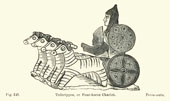Previous First Next
SALAMIS IN THE ISLAND OF CYPRUS.
BY ALEXANDER PALMA DI CESNOLÀ, F.S.A.,
page 110
young woman; the holes by which this mask was affixed to the face are distinctly seen at its sides and above the forehead. Traces of deep red colour are on the hair. It may, perhaps, represent Ariadne. There are fragments of other masks, including one which is that of a child—a fine, tragic face of a little more than half-life-size, and with a lofty coronet of hair, crowned by an ornament of the usual kind. Another represents by its much-injured features the signs of a fine style and period of art. A considerable number of lions, one (fig. 241) inscribed with  , partly Cypriote, partly Phœnician characters; dogs of various breeds, one inscribed with the word , partly Cypriote, partly Phœnician characters; dogs of various breeds, one inscribed with the word  , part of a word, or "a gift" (fig. 242); pigs, cocks, swans, eagles, foxes, horses; a dove with a ribbon round its neck, and other doves in different , part of a word, or "a gift" (fig. 242); pigs, cocks, swans, eagles, foxes, horses; a dove with a ribbon round its neck, and other doves in different  attitudes, occur. One of the fragments of horses bears trappings about its head, with very distinct pink colour and wreaths. Another is likewise enriched with wreaths. It is entirely painted. A sow is beautifully modelled. There is a shaggy dog with a necklace and pendants over his shoulders, and what looks like a garland encircling its body. attitudes, occur. One of the fragments of horses bears trappings about its head, with very distinct pink colour and wreaths. Another is likewise enriched with wreaths. It is entirely painted. A sow is beautifully modelled. There is a shaggy dog with a necklace and pendants over his shoulders, and what looks like a garland encircling its body.  These objects are probably votive in their nature. A great number of similar works were discovered at Alambra, inCyprus, near Dali. The collection of terra-cotta toys, if such they are, andnot insignia of the dead, is very curious. They amount to almost four hundred in all, and many of the forms are represented on the accompanying plate xx. Among the creatures represented by these remains are rattles in the forms of pigs, which retain the pellets inside, a donkey with panniers, a bull and various domestic animals. Probably the most curious of all is a tethrippos, or war-chariot, drawn by four horses (fig. 243) yoked in pairs (fig. 244) These objects are probably votive in their nature. A great number of similar works were discovered at Alambra, inCyprus, near Dali. The collection of terra-cotta toys, if such they are, andnot insignia of the dead, is very curious. They amount to almost four hundred in all, and many of the forms are represented on the accompanying plate xx. Among the creatures represented by these remains are rattles in the forms of pigs, which retain the pellets inside, a donkey with panniers, a bull and various domestic animals. Probably the most curious of all is a tethrippos, or war-chariot, drawn by four horses (fig. 243) yoked in pairs (fig. 244)  by heavy bars of wood, cylindrical in form, painted yellow, perhaps to represent wood, and passing through straps or head stalls, behind the ears. This mode of harnessing is still in vogue whenever bulls are used in agricultural operations. The horses are in a line, like other horses in this collection. Each animal is painted in stripes of deep red and black; the head-gear is painted black. The chariot is of the true Greek form, but it has no pole. The wheels, which appear to have been made to represent wood, are painted with a deep, bright red ground, on which black radii, felloes, and tires are painted, as well as the fylfot, so frequent in Cypriote fictilia. Red and black ornaments are depicted on the chariot. The back of the chariot-body shews by heavy bars of wood, cylindrical in form, painted yellow, perhaps to represent wood, and passing through straps or head stalls, behind the ears. This mode of harnessing is still in vogue whenever bulls are used in agricultural operations. The horses are in a line, like other horses in this collection. Each animal is painted in stripes of deep red and black; the head-gear is painted black. The chariot is of the true Greek form, but it has no pole. The wheels, which appear to have been made to represent wood, are painted with a deep, bright red ground, on which black radii, felloes, and tires are painted, as well as the fylfot, so frequent in Cypriote fictilia. Red and black ornaments are depicted on the chariot. The back of the chariot-body shews
Previous First Next
|